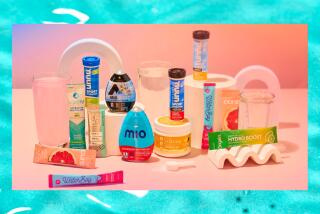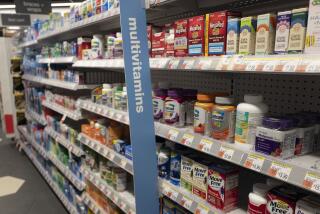Ultraviolet Rays . . . and Vitamin D
- Share via
As spring weather begins to warm the outdoors, many of us around the country are venturing outside to enjoy the bright sunshine. At the same time, exposure to ultraviolet radiation is replenishing our bodies’ supplies of Vitamin D.
Today we take sunshine for granted. But after the industrialization of Northern Europe, crowded housing, narrow streets and smoke-filled skies shut out sunlight and produced an epidemic of the D-deficiency disease, rickets, which lasted for many years.
A scientist ahead of his time, the 19th-Century French physician Armand Trousseau, linked rickets to inadequate diet and sunless climate. He prescribed cod-liver oil and exposure to the sun, bolstered by “good general alimentation (nourishment).”
Unfortunately, by 1900 his precepts were forgotten. Most medical authorities believed that rickets was a chronic infectious disease like tuberculosis and advocated development of a vaccine. Cod-liver oil was dismissed as useless.
Two Sources of Prevention
Finally, in 1919, it was recognized that rickets could be cured by exposure to ultraviolet rays. When cod-liver oil also was hailed as an effective treatment, confusion followed. Then proof emerged that there were two distinct sources of prevention: ultraviolet irradiation of the skin, and foods.
These findings came about the time that vitamins were being discovered. The substance in cod-liver oil known to both prevent and cure rickets was considered a food factor and named Vitamin D.
As it turns out, cod-liver oil is one of few naturally occurring sources of the vitamin. The others are egg yolk, fatty fish, liver and butter. But these foods are either not eaten enough or in large enough amounts, or do not contain sufficient quantities of the vitamin to make meaningful contributions. Moreover, the amounts in foods vary considerably, depending on the animal’s diet and its exposure to sunlight. Ultraviolet light, then, is the primary way nature intended us to get our Vitamin D.
Research has shown that Vitamin D itself has no biological activity in the body. Before it can be used, it must undergo two reactions, the first in the liver and the second in the kidney. When activated, Vitamin D’s most important jobs take place at the intestine, where it facilitates calcium absorption, and in the bone, where it stimulates calcium release.
Vitamin Plays Key Role
Vitamin D is usually associated with bone formation. But it must first maintain blood-calcium levels, critical for the control of nerve conduction and muscle contraction, within strict limits. If insufficient calcium is absorbed from the diet to satisfy these needs, it must be removed from its storage site. Vitamin D plays a key role in this process.
Since it can be produced in the skin, does anyone have to worry about dietary intake? Several factors can hamper Vitamin D formation. In today’s society, many people work inside. When they do go outdoors, the sun’s rays are often blocked by tall buildings or air pollution, not unlike the situation in post-industrial Europe.
In temperate climates, time spent outside is especially limited during the winter months. Ultraviolet exposure is less intense. Serum levels of Vitamin D are known to drop between fall and spring in the colder areas. Also, dark pigmentation prevents a significant amount of ultraviolet rays from penetrating the skin, thereby limiting Vitamin D synthesis.
This does not mean that Vitamin D supplements are in order. The Recommended Dietary Allowance for children through adolescence, and for pregnant and lactating women, is 400 International Units, an amount provided by a quart of Vitamin D fortified milk. Half that quantity of milk will meet the RDA for other adults. And there are many good reasons to drink that much.
Supplements May Be Needed
For people who are housebound and who do not consume enough milk, supplements may be necessary. Individuals taking anti-convulsant medication, which speeds the metabolic breakdown of Vitamin D, may also require an additional source of the vitamin. Any supplements should be prescribed by a physician.
Whether breast-fed babies should receive extra Vitamin D is the subject of controversy. Mother’s milk contains little of the vitamin, but some experts believe that supplements, while not harmful, are superfluous if the mother’s intake was adequate during pregnancy. Again, it is the pediatrician who must decide.
Oversupplementation, at levels not all that high above the RDA, can bring toxic effects. Overdosing is therefore extremely dangerous. By contrast, our skin has a built-in safety system. After a certain amount of ultraviolet exposure, Vitamin D synthesis shuts down. The raw materials from which it is manufactured instead produce inactive metabolites, ruling out danger of toxicity from exposure to the sun.
Water Intake’s Effect on Calcium Supplements for Osteoporosis
Question: I am an 80-year-old woman with osteoporosis, for which my doctor has prescribed a calcium supplement. He also suggested that I take a single multivitamin every day, just to make sure I get all the nutrients I need. I drink between eight and 10 glasses of water a day, and a friend suggested that this could be causing the calcium and vitamins to flush out of my body without being absorbed. Is this true?
Answer: No. In the first place, the amount of water you consume can hardly be described as excessive, particularly if it represents your main source of fluid replacement. Besides the fact that it is essential to take in sufficient water to maintain fluid balance, generous amounts of liquids produce a dilute urine and may help to prevent urinary tract infections and kidney stones. Inadequate intake can lead to increased fluid absorption from the gut, which hinders bowel function.
Beyond these considerations, the amount of water-soluble nutrients that gets flushed out in the urine does not depend on the quantity of water you drink. It is affected first by the body’s ability to absorb a particular nutrient, and second by how much you consume relative to how much your body needs. For example, if your body has as much riboflavin as it can store, the excess portion, whether absorbed from food or from a supplement, will be excreted in the urine.
Q: In a recent column you provided an interesting breakdown on the fat and protein content of various types of milk. Can you tell me whether water is added as part of the procedure to reduce fat content? Also, how does the removal of fat affect the level of nutrients in the milk?
A: Reducing the fat content of milk is accomplished by simply skimming off the cream, not by adding water. The actual volume of fat replaced by the watery portion of the milk is small (only about 2 teaspoons per cup of milk). So there is just a minor rise in the amount of water-soluble nutrients in low-fat and skim milk. Reduced-fat milks with added nonfat-milk solids and, to a greater extent, those with enough milk solids added to be labeled “protein fortified,” do have somewhat larger amounts of water-soluble nutrients.
Thus, a cup of whole milk provides 290 milligrams of calcium and .395 milligrams of riboflavin, whereas a cup of protein-fortified low-fat or skim milk contains about 350 milligrams of calcium and .475 milligrams of riboflavin.
Vitamin A is reduced along with the butterfat, but under federal regulations it must be added to low-fat and skim milk that is transported across state boundaries. Many states have their own regulations for milk produced and consumed within their borders.
Finally, Vitamin D does not occur in appreciable amounts even in whole milk. But it is added to most milks sold in this country. The addition of both these fat-soluble vitamins (A and D) will be declared on the label. If you are using regular milk, it is a good idea to make sure Vitamin D is added. And if you choose low-fat or skim milk, check to see that both A and D have been put in.





